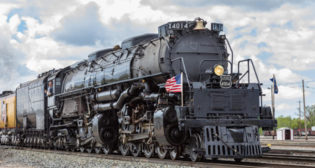
USDOT Issues Safety “Calls for Action” (Updated Feb. 22, Cowen Insight, DOT-117 Data, ACC Statement)
Written by William C. Vantuono, Editor-in-Chief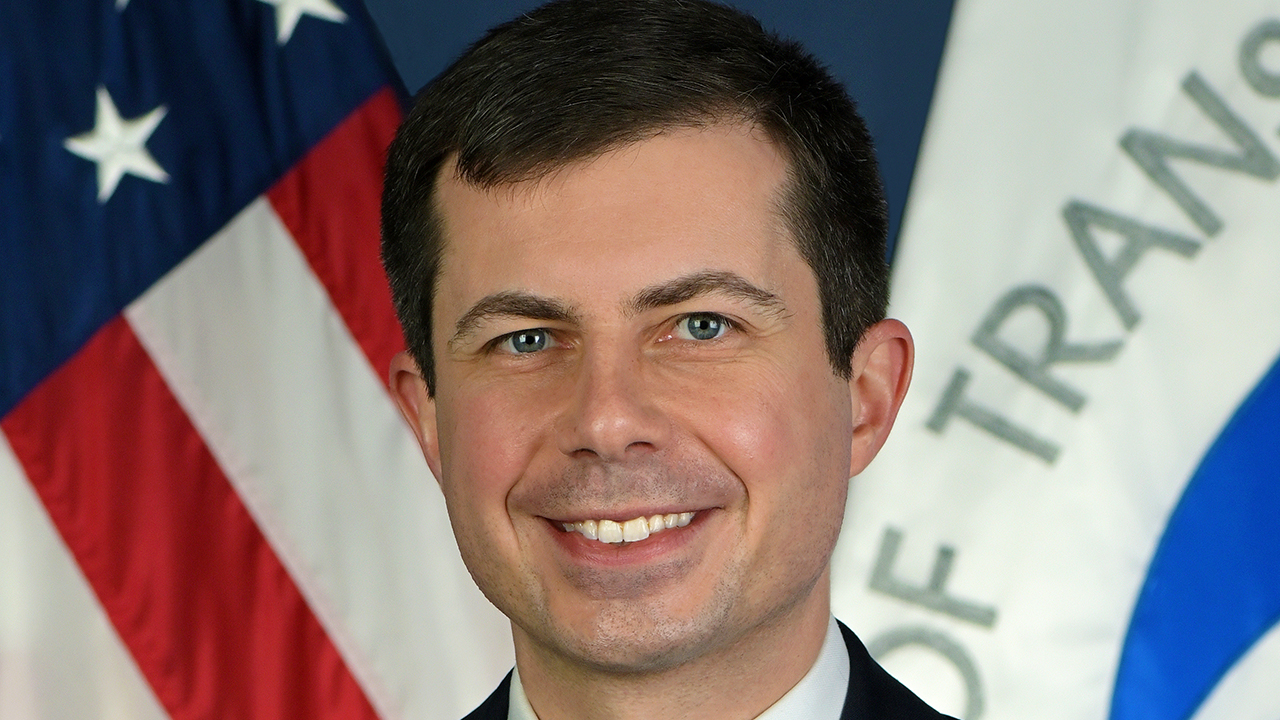
U.S. Transportation Secretary Pete Buttigieg has accused the rail industry of putting “profit and expediency” ahead of “the safety of the American people.” USDOT photo.
More than two weeks after the Norfolk Southern derailment in East Palestine, Ohio that is currently under investigation by the National Transportation Safety Board, the U.S. Department of Transportation has issued “immediate calls for action” described as “commonsense steps … a push to hold the freight rail industry accountable and improve safety.” USDOT’s push involves “accelerating phase-in of safer tank cars, providing workers paid sick leave, and raising existing caps on the fines for rail safety regulations,” the latter through Congressional intervention.
USDOT’s pronouncement immediately followed Transportation Secretary Pete Buttigieg’s letter to Norfolk Southern CEO Alan Shaw in which he called for “an end to the rail industry’s vigorous resistance to increased safety measures, which has included litigation and lobbying Congress … Norfolk Southern and your industry must demonstrate that you will not seek to supercharge profits by resisting higher standards that could benefit the safety of workers and the safety of American communities.” He added that NS should adopt “a posture that focuses on supporting, not thwarting, efforts to raise the standard of U.S. rail safety regulation.”
In accusing the rail industry of putting “profit and expediency” ahead of “the safety of the American people,” Buttigieg said, ”We at USDOT are doing everything in our power to improve rail safety, and we insist that the rail industry do the same—while inviting Congress to work with us to raise the bar.”
The steps include:
- “Protect workers who spot safety issues from reprisal, by joining FRA’s Confidential Close Call Reporting Program. This program allows railroads and their employees to report unsafe events and conditions without fear of negative consequences from the FRA or reprisal from their employers. To date Amtrak, many commuter rail and short line companies are part of this program, but not a single Class I railroad participates. This must change immediately.”
- “Deploy new inspection technologies without seeking permission to abandon human inspections. The removal of human inspections has been a top priority for the rail lobbyists. Recent waiver requests around technology like Automated Track Inspection (ATI) have been framed by industry to set up a false choice between technology and human oversight. We need both to keep our nation’s railroads safe.”
- “Require the owners of tank cars they operate to expedite the phase-in of safer (DOT-117) tank cars in advance of the Congressionally mandated 2029 deadline.”*
- “Provide proactive advance notification to state emergency response teams when they are transporting hazardous gas tank cars through their states instead of expecting first responders to look up this information after an incident occurs. USDOT is also pursuing further requirements in this area, but railroads should not wait.”
- “Provide paid sick leave. A healthy and well-supported workforce is a safer workforce. This doesn’t have to wait for national negotiations—companies can come to terms individually with their labor unions. Some carriers are in the process of doing this. This Administration believes that all workers deserve paid sick leave.”
USDOT said it “will continue, and further enhance, its work on freight rail safety,” including:
- “Advancing the Train Crew Staffing Rule, which will require a minimum of two crew members for most railroad operations. This rule is intended to keep workers and communities safe. Research indicates that an increase in physical tasks and cognitive demands for a one-person crew could potentially lead to task overload or a loss of situational awareness that could cause an accident. Despite two-person train crews being industry standard, the rail industry has resisted being regulated on this front and pushed for crews of less than two people.”
- “Initiating a focused safety inspection program on routes over which high-hazard flammable trains (HHFTs) and other trains carrying large volumes of hazardous material travel.
- “Initiating a focused inspection program of legacy tank cars and the shippers and railroads who have chosen not to upgrade to the safer tank cars (DOT-117).
- “Deploying the resources from the Bipartisan Infrastructure Law under programs including the Consolidated Rail Infrastructure and Safety Improvements (CRISI), the new Railroad Crossing Elimination Program and the Railroad Rehabilitation & Improvement Financing (RRIF) program, among others, to fund projects that modernize and improve rail tracks, eliminate at-grade rail crossings and improve rail safety.
- “Pursuing further rulemaking, to the extent possible under current statute, on high-hazard flammable trains (HHFT) and electronically controlled pneumatic (ECP) brakes.”
Congressional action sought includes:
- “Increasing the maximum fines that USDOT can issue to rail companies for violating safety regulations. The current maximum fine, even for an egregious violation involving hazard materials and resulting in fatalities, is $225,455. This is a rounding error for [Norfolk Southern, which] reported an astonishing record annual operating income in 2022 of $4.8 billion, and has posted operating margins approaching 40%.
- “Following through on new bipartisan support to expand and strengthen rules governing high-hazardous shipments, including high-hazard flammable trains (HHFT), pushing past industry opposition.
- “Following through on new bipartisan support to modernize braking regulations and increase the use of electronically controlled pneumatic brakes (ECP).
- “Speeding up the phase-in of safer (DOT-117) tank cars to carry hazardous materials. Congress established a phase-in schedule under the 2015 FAST Act that gives owners of tank cars until 2029 to fully adopt stronger (DOT-117) tank cars.* The original 2015 HHFT Rule required the phase-in by 2025. Congress can act now to speed, rather than slow, this important safety measure.
- “Increasing funding to expand hazardous materials training for first responders.”
AAR Responds
The Association of American Railroads, in responding to USDOT’s pronouncement, said NTSB’s investigation of the NS accident is being “impeded by politics and speculation.”
“No community should ever face the events of Feb. 3,” said AAR President and CEO Ian Jefferies. “This is why railroads are steadfastly committed to solutions-oriented steps that directly address the cause of the accident and could prevent a similar accident from occurring elsewhere. NTSB’s independent investigators continue their work to identify the accident’s root cause and contributing factors. That investigation must continue unimpeded by politics and speculation so NTSB’s findings can guide what additional measures may have prevented this accident. All stakeholders—railroads along with federal, state and local officials—must work to restore the public’s trust in the safety and security of our communities. We can only do that by letting the facts drive the post-accident response. At this time, the focus must be on the most pressing issue at hand—ensuring the community of East Palestine has all the support it needs as it moves forward.”
Among the facts to which AAR is referring are how the hazmat on the NS train (vinyl chloride) was classified, and whether the consist should have been equipped with ECP brakes. Non-ECP brakes have been described in the national news media as “Civil War era” and “19th Century technology.”
NTSB Statement
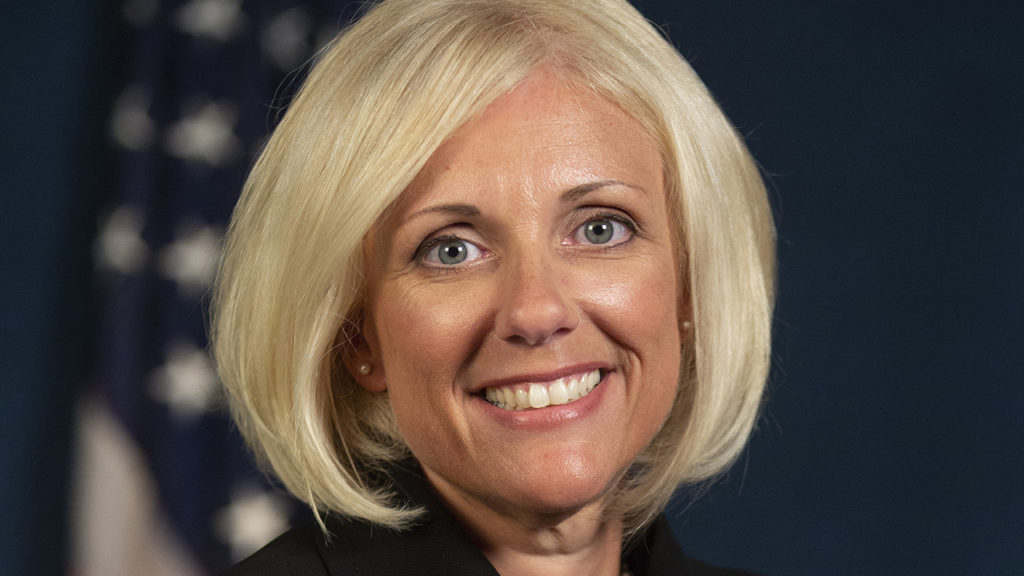
NTSB Chair Jennifer Homendy, in a series of tweets on Feb. 17, said, “To everyone affected: Know that NTSB is working vigorously to understand what caused this train derailment—so it never happens again … NTSB investigators will thoroughly examine the tank cars once decontaminated. As always, we’ll issue urgent safety recommendations as needed. Urgent safety recommendations may be issued at any time; meaning, we don’t wait until the end of our investigation if immediate safety action is warranted.
“Nothing is more important than accuracy at a moment like this, which is why the NTSB is deliberate in our approach to investigations … Anyone speculating about what happened, didn’t happen, or should have happened is misleading a suffering community.
“Some are saying the ECP brake rule, if implemented, would have prevented this derailment. That is false. The ECP braking rule would have applied only to HHFTs. The train that derailed in East Palestine was a mixed [consist] containing only 3 placarded Class 3 flammable liquids cars. This means even if the rule had gone into effect, this train would not have had ECP brakes.”
Homendy pointed to a U.S. General Accountability Office (USGAO) graphic explaining how a December 2015 FAST Act directive resulted in PHMSA (Pipeline and Hazardous Materials Administration) withdrawing the ECP brake rule on Sept. 24, 2018:
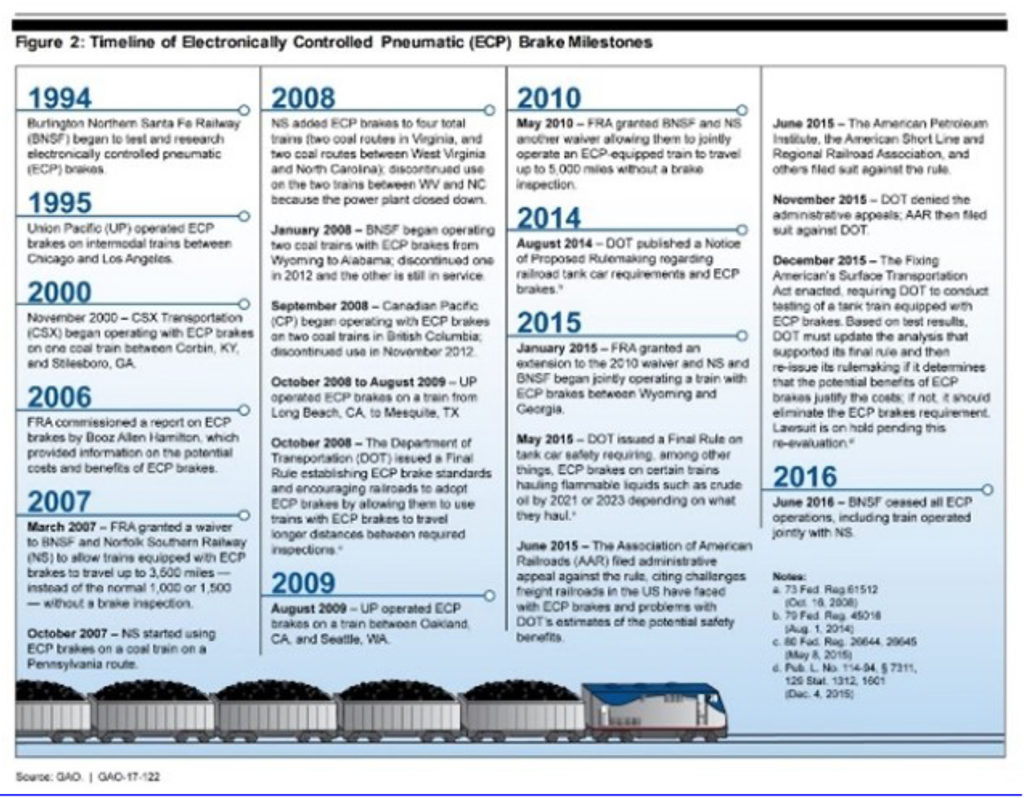
Shaw Pays Second Visit to East Palestine
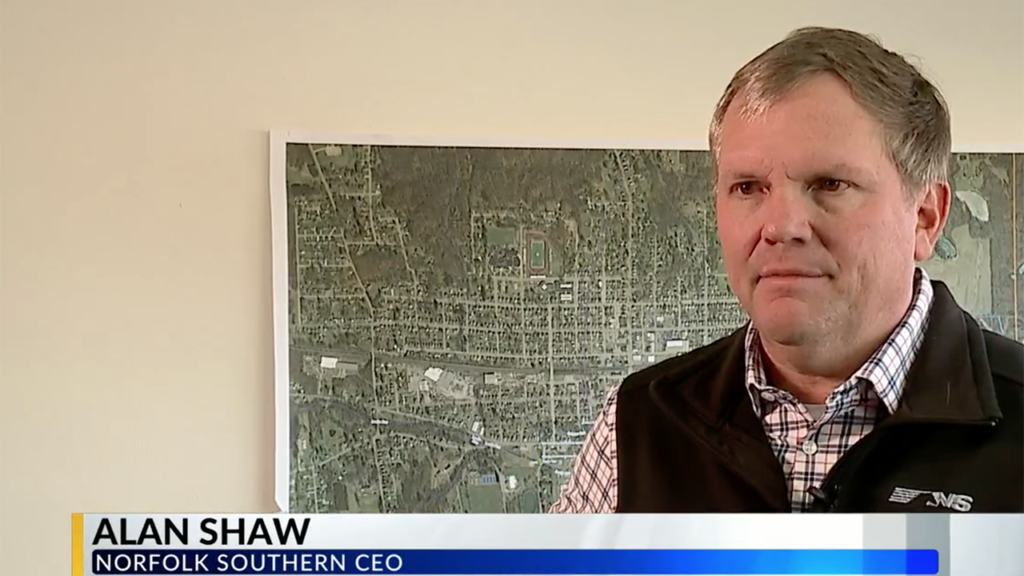
On Feb. 19, Alan Shaw visited East Palestine for the second time, meeting with community members, local leaders and Norfolk Southern railroaders “who call the area home,” NS said. He also spent time with the crews working around-the-clock at the incident site. Shaw attended the Feb. 6 meeting where the decision was made to initiate controlled release and burn-off of hazmat from the tank cars involved in the derailment.
Shaw released a statement after completing his second visit:
“I returned to East Palestine today to meet with local leaders, first responders, and a group of Norfolk Southern employees who live in the area. I started the morning walking the derailment site to see our clean-up progress first-hand. We are working closely with Ohio environmental and health agencies on the long-term plan to protect the environment and the community. We are going to do the work thoroughly, completely, and safely.
“I also went to the home of one of our Norfolk Southern railroaders who lives in East Palestine, where I talked with a group of his friends and neighbors. I appreciated the chance to hear their concerns and I asked them how Norfolk Southern could help. They want to know we are going to do the right thing for their community, and I am determined to earn their trust.
“I had a series of meetings with Mayor Conaway and several community leaders, Congressman Bill Johnson (R.-Ohio), and Fire Chief Drabick, along with several of his first responders. They are frustrated by the amount of misinformation circulating about their community and are eager to show that the air and water are safe.
“In every conversation today, I shared how deeply sorry I am this happened to their home. We are going to do the right things to help East Palestine recover and thrive again.”
NS established a resource page on its website, “Making it Right in East Palestine,” with information and multiple links to additional resources.
In an interview with CBS affiliate WKBN-27 First News, Shaw said NS is offering $1,000 per person to all those with a 44413 zip code and Beaver County’s evacuation zone. When asked if NS was “making them sign documents to tell people they won’t sue further if they can’t ask for more money?” he replied, “No. Not at all. All they have to do is sign their name [to acknowledge] they’ve received a thousand dollars.”
Transportation Secretary Buttigieg told reporters on Feb. 21 that he plans to visit East Palestine “when the time is right,” according to a CNN report. “I am very interested in getting to know the residents of East Palestine, hearing from them about how they’ve been impacted and communicating with them about the steps that we’re taking,” he said, referring to “past common practices of transportation secretaries” by deferring first to the NTSB after a major disaster like the derailment. “But yes, when the time is right, I do plan to visit East Palestine,” he said. ”I don’t have a date for you right now.”
COWEN INSIGHT: “POTENTIAL OPPORTUNITY FROM NEW DOT PROPOSAL”
“The DOT on Feb. 21 said it was calling on the rails to act immediately to, among other things, require the owners of tank cars to expedite the phase-in of DOT-117 tank cars in advance of the Congressionally mandated 2029 deadline,” comments Cowen and Co. Transportation Equipment OEM Analyst Matt Elkott. “According to the most recent public data from the Association of American Railroads (AAR), there are more than 35,000 noncompliant tank cars (7,360 of which are DOT-111 and CPC-1232) are that need to be replaced or retrofitted.”
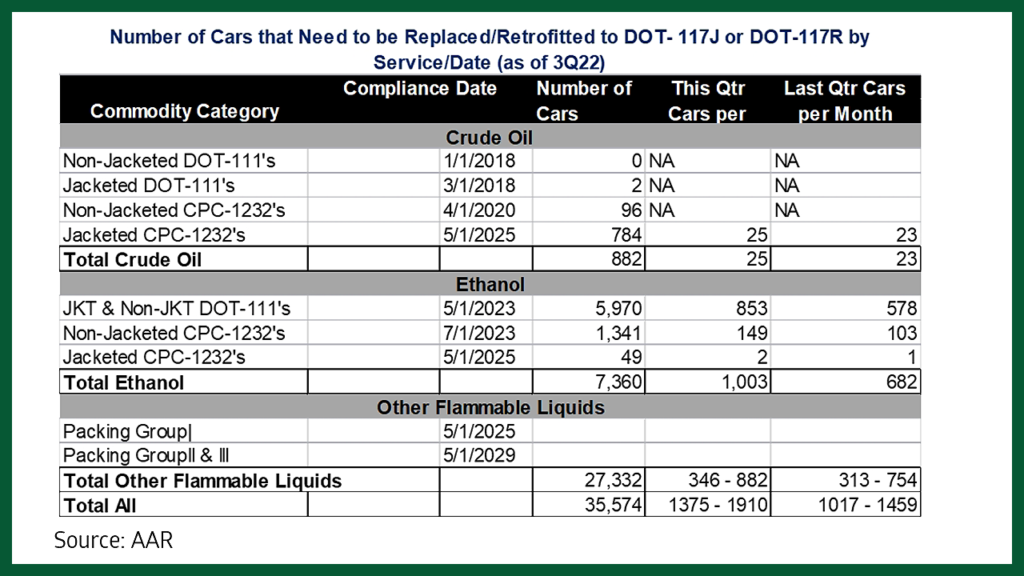
“We estimate that Trinity (TRN) and Greenbrier (GBX) have more than 70% of the North American tank car market. We estimate there could be ~4% and ~7% earnings upside for TRN and GBX, respectively, from an incremental 1,000 cars produced or retrofitted by each company in 2024. We see the industry being able to produce or retrofit ~7,500 tank cars in 2024 incremental to total build expectations of 40-45,000 railcars (largely in line with the 2023 number TRN cited for the industry) while also meeting the 2023-2026 scheduled maintenance timeline, assuming supply chain and labor disruptions abate by the end of this year. This would put the combined 2024 opportunity for TRN and GBX at more than 5,000 incremental tank cars. There would be additional opportunities for 2025-2028.
“After a series of capacity rationalizations, we estimate that the maximum industry production output is 65,000 cars/year, down from 82,000 units in 2015. Wabtec (WAB) could also see a modest benefit from higher industry builds. The company likely has $4-$10,000 of content per railcar, with a maximum content opportunity closer to $30,000/car. We believe the railroads could voice support for such a recommendation as it could improve safety, limit liability, and is unlikely to require much investment from the railroads themselves.
“The DOT also noted that it could pursue further rulemaking, to the extent possible under current statute, on high-hazard flammable trains (HHFT) and electronically controlled pneumatic brakes (ECP). It recommended that Congress follow through on new bipartisan support to modernize braking regulations and increase the use of ECP. This could be a long-term positive for WAB, although it is hard to gauge how much traction this somewhat vague proposal could have and what it could actually lead to. Requiring ECP on a train would mean all railcars involved would also have to have electronic braking (not just those carrying flammable liquids). Additionally, the [NS] derailment was not caused by a braking problem.”
*EDITOR’S NOTE: According to Railway Supply Institute Tank Car Commitee data, the number of tank cars still to be upgraded to DOT-117R (retrofit) standards is small, and the deadline is, in any case, 2023 or 2025. DOT’s proposal does not apply and its information is incorrect, as far as DOT-117 cars are concerned. The 2029 deadline only applies to tank cars for Packing Groups I, II and III, “Other Flammable Liquids”—not crude oil and ethanol. In fact, retrofits of crude oil and ethanol tank cars are progressing at a steady pace and are on target to meet or exceed the deadlines.
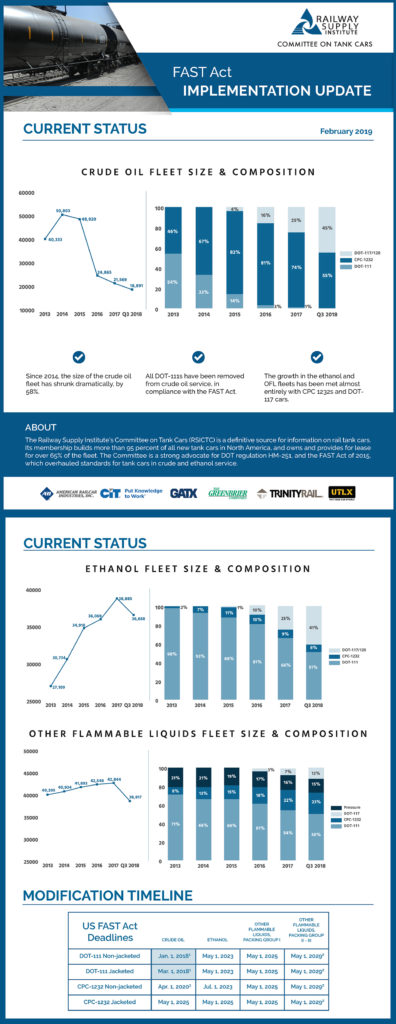
ACC Statement Regarding East Palestine Derailment
American Chemistry Council (ACC) President and CEO Chris Jahn on Feb. 22 issued the following statement on the NS derailment :
“We commend the emergency response teams, local officials and rail workers for their tireless efforts to help keep the residents of East Palestine and their community safe. We also appreciate the hard work of the government personnel who are onsite providing support and important public health information.
“People are understandably concerned and question why we ship chemicals, including those that are classified as hazardous materials. We ship them because they are needed across the country and essential to everyday life. Chemicals are critical to providing safe drinking water, ensuring a plentiful food supply, producing life-saving medicines and medical equipment, and generating many types of energy.
“The impact of the derailment on the community of East Palestine underscores the need for a constant focus on safety. We must strive to meet the daily needs of the nation while delivering materials safely.
“The safe transportation of chemicals is a responsibility shared between chemical manufacturers, our transportation partners and the government. The transportation of chemicals requires a full range of safety measures to help prevent derailments, reduce the risk of a material release and mitigate the impacts of an accident.
“Chemical manufacturers own or lease railcars used to ship our products, including tank cars equipped with special safety features to help prevent the release of chemicals during a derailment. Shippers have made significant investments in recent years to upgrade their fleets and will continue to do so.
“Experience has shown that advancing safety requires us to apply the lessons learned from accident investigations and rely on scientific data to determine what safety measures will deliver the greatest benefit.
“ACC and its members are committed to working with our transportation partners along with policymakers and other stakeholders to promote the safety of the products of our industry and help protect the public from future accidents.”



